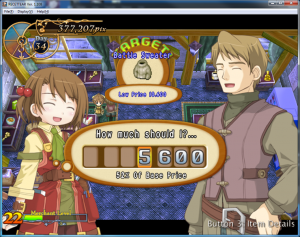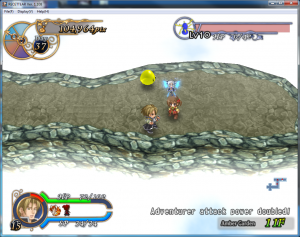GotM – Recettear
Shop sims have always interested me. A long, long time ago (I was… well, let’s just say this was around ’92), I was fascinated by an edutainment store simulator I remember only as “Bentley Bear’s Store”. I would play this game nonstop when I would get a chance, at a computer learning camp I attended through early elementary school. (Googling does not bring up the game, although it does indicate Bentley Bear was the main character in Crystal Castles – no help).
In this ancient shop simulation, you would buy various items (clothes, appliances, and so on) at a base price, and sell these items at a markup, arranging them in your store to draw in customers. You could even visit the nearby department huge store to view their prices, and undercut them slightly to draw in more people. I think there was even an initial debt to repay.
After I stopped going to that computer camp, I simply stopped playing the game. It was sort of interesting, but back then the internet was a mere fledgling of what it is now, and I doubt that the halls of AOL or Compuserve would have had any information on it regardless.
Recettear is the modern Bentley Bear’s Store. Known long-form as “An Item Shop’s Tale”, Recettear is the poster child for translation of Japanese indie (often called “doujin”) games. Much like the store-sim game of my youth, in Recettear you purchase items from either a Guild Shop or the global Marketplace, and sell them at a negotiated markup (that markup often depending upon the willingness of the customer in question to haggle). You arrange them in the store in such a way as to draw in customers, and later you can even design the walls, floor, and counters of your store to attract specific kinds.
One aspect that makes Recettear more interesting is that it adds many sub-mechanics on top of a simple store sim. Initially, prices are static and you merely sell things that you put out on display. As you progress, your customers will start to bring in stuff they wish to sell – most often food or “treasures” (antiques, statuettes, and other things) that can be hard to resell. Price of goods will fluctuate – sometimes wildly, giving the advantage to the savvy store owner who stocks a large variety of goods. For example, I was selling a ton of weapons and suddenly the price for metal hits rock bottom. Losing money on sales is bad – but at the same time, price of sweet foods went up. I had a few melons and a bunch of other fruit stocked up, so I revamped my stock and made a killing. Each customer type has an “affection”, or stated more directly, Loyalty rating, as well – so there may well be advantage to selling things directly asked-for at a loss. More loyal customers will come in more often, with more money in their pockets, and will haggle less. Certain (named/portraited) customers, once they become loyal enough, will give you their Adventurer card, allowing you to use them in dungeon-delves to acquire new goods.
Being such an experimental game, however – despite drawing on such classic sim fare – Recettear has rough edges. Dungeon-delving might seem fundamental to a game with a fantasy theme, but in reality it isn’t that helpful. The first few sets are pretty useful, often yielding on-par or better gear than can be initially bought and helping to unlock recipes to create still better equipment. After that point, there is a steep dive in quality which is aided by a devious random number generator. On floor 5 of the third dungeon, I found an iron breastplate worth $8000. Decent money for that point. Not a single treasure chest from then until floor 35 had anything worth more than $1100, making the entire delve a waste of time (aside from meeting a new “customer”). Adventuring takes two of the four timeslots in a day, and I could’ve earned $50,000 easily had I spent that half of the day tending shop instead.
Despite all this, adventuring makes for a nice change of pace in a game that is largely about numbers and the overall experience benefits from a little adventuring.
On my initial playthrough (recently completed my second), I found hitting the targets for debt repayment increasingly difficult until – on the final repayment – I had to hang up my shopkeeping hat, run over to the Guild Shop, and sell every single item I had at a significant loss, just to win the game. From that experience I learned it is much better to offer prices people will initially accept (generally, 105-110% depending on the customer) than to suggest prices and have them haggle (~130%, which only the guild master will actually accept). This drives up your merchant XP, giving you earlier access to better goods – and earlier access to price fluctuation, which can earn you a huge amount of money.
Although Recettear is now old-hat (oh my, it was released 7 months ago!) and long since had a significant boom in sales (ensuring Carpe Fulgur will stay around to localize more titles), it is still well worth the $20 price of entry. It’s a quick, fun play-through (9-10 hours at most) and even offers additional plot to those willing to plumb its depths in the Endless Mode following the “normal” game.
Note, this marks the transition of Game of the Day to Game of the Moment. Thanks to you-know-who-you-are for this suggestion to keep me consistent. No, I’m not renaming old ones, so it’s not going to be consistent. Take that.

